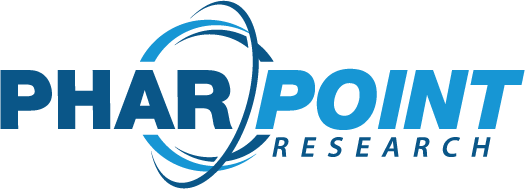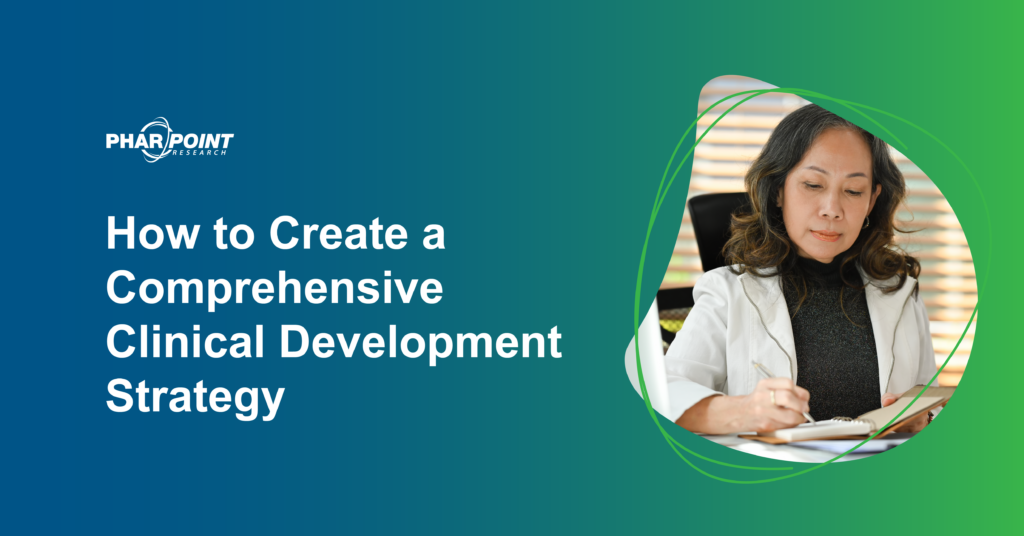How to Create a Comprehensive Clinical Development Strategy
The drug development process is a long and risky endeavor, with over 90% of new therapies that enter Phase 1 clinical trials ultimately failing to obtain regulatory marketing approval [1][i].
While necessary, demonstrating the efficacy and safety of a new compound alone is insufficient in assuring cost-effective development or successful launch and commercialization[2].
Along the path to approval, Sponsors face many barriers that can complicate the development process, resulting in delays, cost overruns, or the end of a program entirely.
A strategic, comprehensive clinical development plan (CDP) can help Sponsors optimize efficiency, control costs, plan timelines, and maximize the probability of success for a new drug program.
Such a strategy encompasses various aspects of a program and can yield several benefits for a company, including:
- Early identification of potential pitfalls
- Optimization of study timelines and costs
- Confidence among decision-makers and potential partners
Creating an effective CDP requires a consultative, multidisciplinary team of experts. A comprehensive drug development strategy typically includes [3]:
- A target product profile (TPP) that defines the key characteristics of a drug product;
- A regulatory strategy that takes into consideration the current opinions of health authorities and the requirements of different jurisdictions;
- A non-clinical plan that looks at in vitro and in vivo reports and findings to ensure data are scientifically sound and adequate to support proposed clinical trials;
- A clinical development plan that strategically plans out the clinical trials required for market approval;
- A Chemistry, Manufacturing, and Controls (CMC) strategy that includes costs for drug supply and formulation strategy, including costs for any placebo or comparator drugs;
- A commercial plan that favorably positions your product with key opinion leaders and other stakeholders.
What should you include in your TPP?
The TPP defines the key characteristics of the marketed drug product[4]. It typically includes information such as:
- Indication or disease(s) to be treated;
- Patient population(s) projected to be treated;
- Therapeutic efficacy and clinical safety;
- Formulations, dosing regimens, and administration; and
- Potential drug-drug interactions and contraindications or precautions.
A TPP should be a living document that can help guide the design of all program activities, including non-clinical and clinical studies. As your TPP evolves, it will eventually provide the basis for preparing the final approved product label.
Developing your Regulatory Strategy
The drug regulatory environment is complex and can vary significantly between regions and jurisdictions. Regulations may also evolve and develop during a product development life cycle, creating frustrating obstacles for a program without a sound regulatory strategy.
Regulatory experts may help Sponsors determine a recommended pathway for approval and evaluate special options for accelerated review and approval.
Creating a timeline for major regulatory submissions and additional agency interactions, along with plans to ensure those interactions are effective, can clarify the process.
The regulatory landscape can be complex, but no one wants to see a promising product stall due to poor regulatory planning. Working alongside a niche expert with experience with the FDA and other regulatory agencies can help you prepare key questions to ask and address as a product progresses through the clinical trial process.
Preparing your Non-Clinical Strategy
Advancing a drug into initial Phase 1 development requires the completion of a suite of non-clinical studies. These studies must comply with detailed regulatory guidelines such as GLP and ICH. They must provide enough rigor for regulatory agencies and oversight committees to agree that a drug is appropriate for human administration at planned doses in clinical trials[5].
Later clinical development and regulatory marketing approval require additional non-clinical studies. These non-clinical studies may include longer-duration toxicology and reproductive technology, carcinogenicity, and bio-distribution studies. Studies may also be needed to address concerns about a specific drug or its molecular target and mechanism of action.
As you prepare your non-clinical strategy, you should begin with a thorough technical, scientific, and regulatory review of all available non-clinical reports and findings (including in vitro and in vivo studies). Non-clinical experts should work closely with colleagues in other disciplines to assess whether the available data are scientifically sound and adequate to support proposed clinical trials and meet all relevant regulatory guidelines.
What is a Clinical Development Strategic Plan?
Clinical trials can be a program’s most expensive and high-risk component [6]. These trials will also drive financial and resource decisions as the development of the asset matures.
To begin designing a clinical trial program, subject matter experts should review the preclinical profile of the new drug candidate and provide clinical trial design suggestions and proposed therapeutic use in patients. The medical and scientific rationale for the drug product should be assessed to ensure that the marketed product is likely to gain acceptance by healthcare providers, patients, and professional medical organizations.
The clinical plan may include information such as:
- Trial details, from initial Phase 1 through Phase 3, including information like key endpoints, inclusion/exclusion criteria, and approximate subject numbers
- A “proof-of-concept” definition that can help Sponsors make a “Go/NoGo” decision based on the efficacy performance of a drug candidate.
- Post-approval plans for Phase 4 trials
- A high-level timeline, including cost and resource commitments
- A comprehensive risk management strategy
CMC Strategy
A CMC plan functions as a vital component of a fully integrated development plan by outlining the significant features of a drug supply and formulation strategy and any placebo or comparator drug supply needs. A CMC plan also assesses the estimated cost of goods for the drug substance and final market product, a critical factor in new drug development[7].
Preparing a CMC strategy should begin with a thorough technical, scientific, and regulatory review of all available data on the drug substance or active pharmaceutical ingredient (API). Examining existing pilot drug formulations allows you to assess whether available CMC data can support proposed trials and meet relevant GMP regulatory requirements. That review can outline any additional CMC work needed during development.
Commercial Strategy Plan
Planning a commercial strategy begins with a thorough review and analysis of the competitive landscape for a product, considering efficacy, safety profile, costs, prescriber and patient satisfaction, and upcoming treatments in the pipeline.
An effective commercial strategy can[8]:
- Inform differentiation from competitors;
- Specify data that should be obtained to demonstrate value;
- Help you favorably position a product with KOLs and other stakeholders.
Whether conducted during Phases 1-3 or following approval in Phase 4 studies, a competitive landscape analysis can influence the design of a program’s clinical trials. A commercial strategy identifies the most critical health economic endpoints to include in clinical trials. It can also suggest how to obtain relevant data via approaches other than traditional interventional clinical trials, such as real-world evidence (RWE).
Even at the very early stages of planning a drug development program, formulating a commercial strategy can identify critical success factors that might be overlooked. It can also recommend the best methods for effectively communicating results to stakeholders to maximize market access and the value of a new drug product.
Conclusion
In summary, a comprehensive development strategy is a vital tool for pharmaceutical and biotech companies. It helps navigate the complexities of drug development, minimizes risks, optimizes timelines and costs, improves regulatory success rates, and inspires confidence among decision-makers and potential partners. Most importantly, a comprehensive plan helps sponsors bring innovative medicines through the drug development pipeline faster – because patients are waiting.
Sources
[1] Sun D, Gao W, Hu H, Zhou S. Why 90% of clinical drug development fails and how to improve it? Acta Pharm Sin B. 2022 Jul;12(7):3049-3062. doe: 10.1016/j.apsb.2022.02.002. Epub 2022 Feb 11. PMID: 35865092; PMCID: PMC9293739.
[2] From idea to market: the drug approval process. M S Lipsky, L K Sharp The Journal of the American Board of Family Practice Sep 2001, 14 (5) 362-367
[3] Elizabeth Kwong, Advancing Drug Discovery: A Pharmaceutics Perspective, Journal of Pharmaceutical Sciences, Volume 104, Issue 3,
2015, Pages 865-871, ISSN 0022-3549, https://doi.org/10.1002/jps.24294. (https://www.sciencedirect.com/science/article/pii/S0022354916300132)
[4] Tebbey, P. W., & Rink, C. (2009). Target Product Profile: A Renaissance for its Definition and Use. Journal of Medical Marketing, 9(4), 301–307. https://doi.org/10.1057/jmm.2009.34
[5] Gursharan Singh, Chapter 4 – Preclinical Drug Development, Editor(s): Divya Vohora, Gursharan Singh, Pharmaceutical Medicine and Translational Clinical Research, Academic Press, 2018, Pages 47-63, ISBN 9780128021033
[6] Eisenstein EL, Collins R, Cracknell BS, et al. Sensible approaches for reducing clinical trial costs. Clinical Trials. 2008;5(1):75-84. doi:10.1177/1740774507087551
[7] William F. Salminen, Olu Aloba, Angela Drew, Agnieszka Marcinowicz, Madelyn Huang, US FDA 505(b)(2) NDA clinical, CMC and regulatory strategy concepts to expedite drug development, Drug Discovery Today, Volume 28, Issue 7, 2023, 103618, ISSN 1359-6446
[8] Paich, M., Peck, C. and Valant, J. (2011), Pharmaceutical market dynamics and strategic planning: a system dynamics perspective. Syst. Dyn. Rev., 27: 47-63. https://doi.org/10.1002/sdr.458



